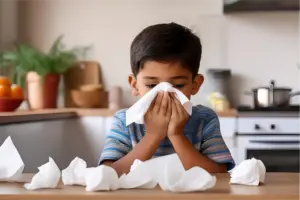
Norovirus Stomach Pain as a person suffering with abdominal pain and cramps due to a contagious flu infection as a stomachache viral sickness.
As India focuses on Human Metapneumovirus (HMPV), the United States is grappling with a rise in norovirus cases, a highly contagious virus often called the “vomiting bug.” Here’s what you need to know about norovirus and how to protect yourself
What is Norovirus?
Norovirus belongs to the Caliciviridae family of viruses, causing inflammation in the stomach and intestines and leading to symptoms such as vomiting and diarrhea.
Discovery: Identified in 1968 following a gastroenteritis outbreak in Norwalk, Ohio.
Prevalence: According to the CDC, norovirus is the leading cause of vomiting, diarrhea, and foodborne illnesses in the U.S.
How Does Norovirus Spread?
Norovirus is extremely contagious and spreads through:
Contaminated Food or Water: Ingesting tainted items.
Infected Surfaces: Touching contaminated areas and then your mouth.
Direct Contact: Being in close proximity to an infected person.
Symptoms of Norovirus
Symptoms typically emerge 12–48 hours after exposure and may include:
Nausea and vomiting.
Watery diarrhea.
Stomach cramps.
Fever, body aches, and severe dehydration in extreme cases.
Preventive Measures
To lower your risk of contracting norovirus:
Wash Hands: Use soap and water frequently, especially before meals and food preparation.
Disinfect Surfaces: Regularly clean shared spaces and high-touch surfaces.
Avoid Contaminated Food/Water: Steer clear of food or drinks prepared by someone who is unwell.
Stay Hydrated: If symptoms arise, focus on hydration and seek medical help for severe dehydration.
Why Awareness Matters
Norovirus outbreaks often spike in winter, but increased awareness and preventive action can significantly reduce its impact. Stay informed and proactive to protect yourself and your family from this “vomiting bug.”
For more health updates and practical tips, visit Newzhealth.com








